
|
Philippines, 19 Dec 2025 |
Home >> News |
 |
||||
|
|
|
|
Sol Levinson: The Man Whose Gloves Elevated Boxing By Emmanuel Rivera, RRT PhilBoxing.com Tue, 06 May 2025 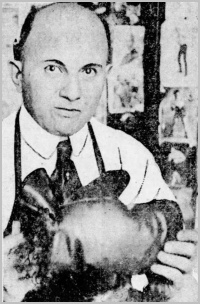 Behind every devastating punch is an organic hero— the gloves. Solomon “Sol” Levinson understood this better than anyone. He set out to change the fight game by crafting the best fighter’s gloves possible. In boxing, as in life, greatness isn’t just about skill, power, or strategy— it’s about how they all come together in perfect harmony to achieve the desired effect. From the late 19th century to the 1930s, Levinson’s gloves weren’t just gear; they were a boxer’s most essential tools. His creations set the gold standard for safety and performance…so much so that before major bouts at Madison Square Garden, his gloves were locked in a safe, guarded like the championship belts themselves. A Life Built in Boxing Born in November 1867 in Vallejo, California, Sol Levinson grew up in a pioneering Jewish family. His father, Abraham, and uncle Friedman had emigrated from Zempelburg, Prussia, settling in California by the 1850s. Life was tough…the family moved frequently, with Abraham running a general store in Lake County. Tragedy struck early. By 1879, Sol had lost his father and three of his siblings. His mother, Henrietta, now a widow, moved the family to San Francisco, hoping for a fresh start. At just 16 years old, Sol entered the city’s booming leather goods industry. He got his start at Blumenthal & Co., a fine glove manufacturer, before honing his skills as a glove cutter at Shoenberg & Co. By the mid-1890s, he had mastered his craft and married Maude Valentine, a woman from a family also involved in the glove trade. Together, they welcomed their only child, Aubrey Levinson, in 1896. Around this time, Sol took an unexpected step into the world of boxing, and the pugilistic sport would never be the same. Despite his success, Sol’s personal life had its hardships. After divorcing Maude in 1904, he remarried Gertrude Farley, who sadly passed away a year later. 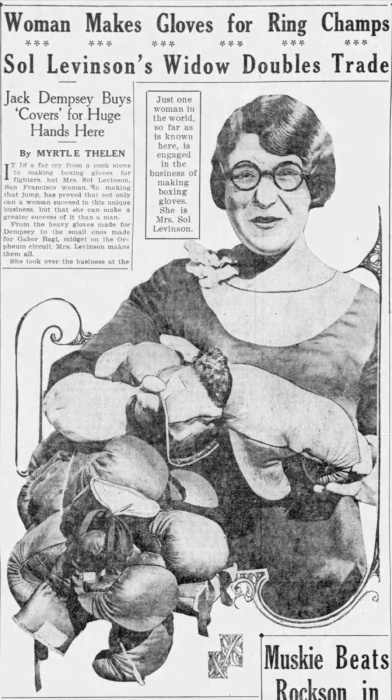
Credit: San Francisco Bulletin (San Francisco, California, Sat, Dec 5, 1925) In 1917, he found love again with Florence Hayes, who would later help manage his business. 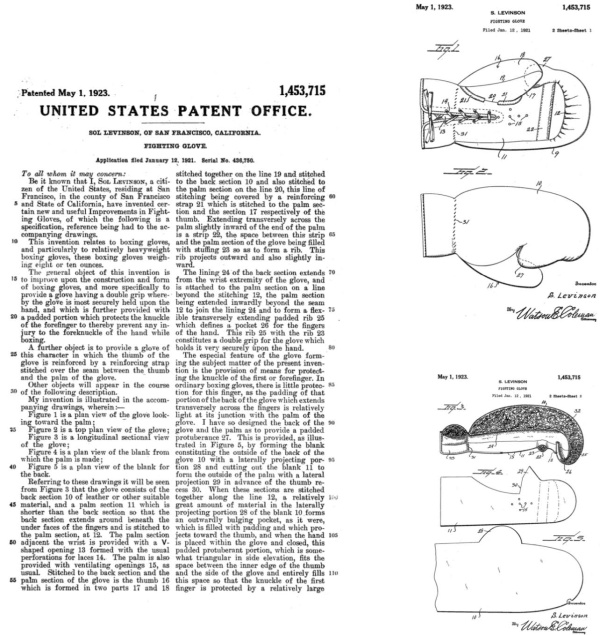
Revolutionizing the Boxing Glove The story of Sol Levinson’s first boxing glove is one of necessity and innovation. Sometime in the late 1890s, a friend from the boxing world approached him with a challenge: “Can you make a glove that allows fighters to form a natural fist while still protecting their hands?” At the time, boxing was a far more brutal sport than it is today. Even after the Marquess of Queensberry Rules mandated gloves in 1867, enforcement remained inconsistent. It wasn’t until 1892 when gloves were made mandatory for the heavyweight championship bout between John L. Sullivan and James J. Corbett, that the bare-knuckle era effectively came to an end. However, the gloves of that era were crude— fighters still suffered broken hands, severe facial injuries, and, in some cases, career-ending damage or even death. Levinson recognized the problem and went to work. The result? A game-changing glove that redefined the sport. • Curved shape – Allowed fighters to form a more natural fist. • Extra knuckle padding – Reduced hand injuries and extended careers. • Double grip system – Secured the glove for better control. • Padded thumb design – Helped prevent accidental and intentional eye gouges. 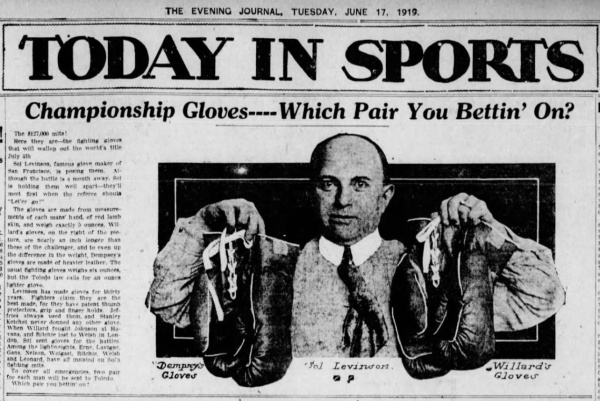
Source: The Evening Journal (Wilmington, Delaware) • Tue, June 17, 1919 • Page 17 The Original Choice of Champions His big break came in 1897, when heavyweight legend Bob Fitzsimmons insisted on wearing Levinson’s gloves for his fight against Jim Corbett in Carson City, Nevada. From that moment on, every champion wanted Levinson’s gloves. By the early 1900s, three out of four championships and settos of significance were fought using gloves they’ve simply referred to as Levinsons. Some of the greatest boxers swore by them, including Jim Jeffries (who reportedly broke his hand using another brand and refused to wear anything but Levinsons thereafter), Jess Willard, Joe Gans, George Dixon, Jack Johnson, Gene Tunney, and Jack Dempsey. Sol Levinson was deeply involved in the sport. By 1909, he was managing fighters, training young boxers, and refereeing matches. Levinson wasn’t just making gloves— he was shaping fistic history. In 1904, he opened his own business, Sol Levinson, Glovemaker, at 1443 Fillmore Street in San Francisco. In 1913, he relocated his leather factory to 1028 Market Street, on the main streetcar line in downtown San Francisco, where it remained until 1929. The United States military tapped Levinson to protect our sailors’ and soldiers’ fists. Blared one headline, UNCLE SAM TO "MIT" "KAISER BILL" WITH A "K. O." IN EACH HAND …Army and Navy Lads Become Acquainted With Sol Levinson's Boxing Gloves… 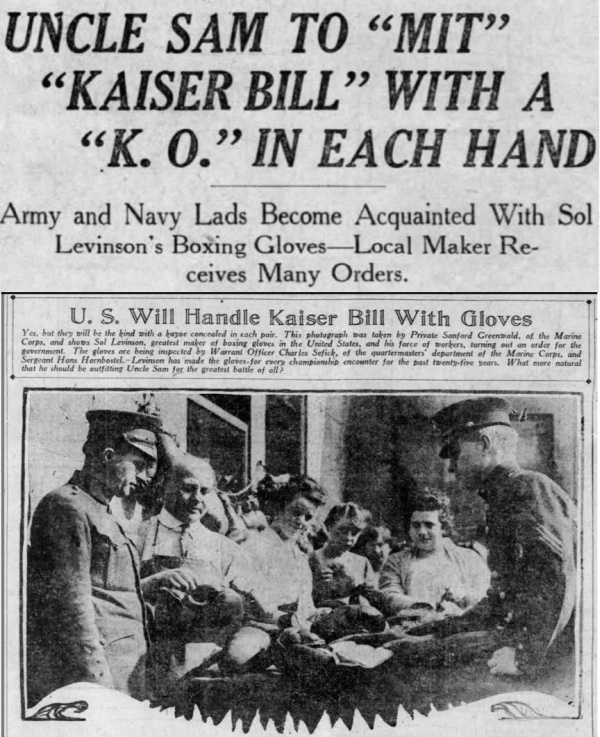
Bulletin (San Francisco, California) • Sat, Mar 2, 1918 • Page 8 Boxing’s Golden Age The 1910s and 1920s were boxing’s golden age, and Sol Levinson’s gloves were at its heart. Some of the blockbuster fights of the era featured his handiwork, including Jack Johnson vs. Jim Jeffries (1910), Jess Willard vs. Jack Johnson (1915), and Benny Leonard’s lightweight championship fights 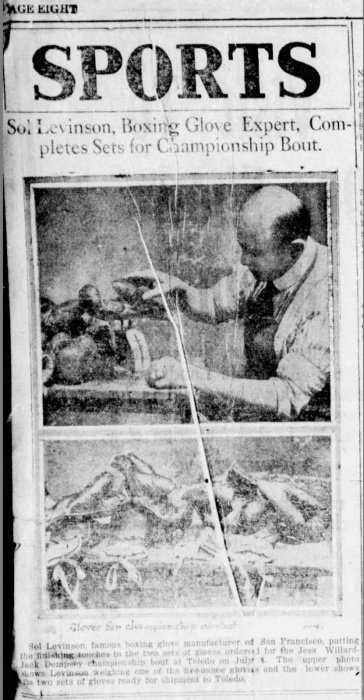
Source: The Morning Herald (Durham, North Carolina) • Sun, Jun 29, 1919 • Page 8 But nothing compared to July 2, 1921—the Jack Dempsey vs. Georges Carpentier fight, known as the “Battle of the Century.” It was the first million-dollar gate in boxing history. Over 91,000 fans packed Boyle’s Thirty Acres in Jersey City, including Henry Ford, John D. Rockefeller Jr., and Al Jolson. The New York Times reported that both fighters were wearing Levinson gloves. In 1923, when Jess Willard fought Luis Firpo, Levinson was commissioned to make extra-large gloves for the bout—so valuable that they were locked in a safe before the fight. 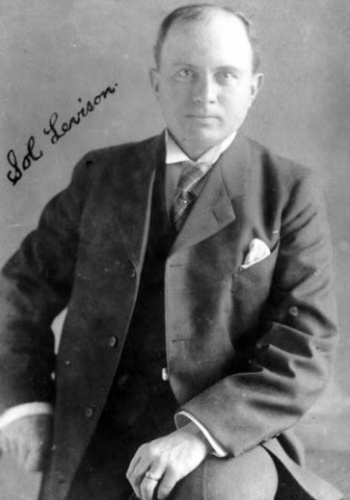
A Legacy By 1925, Sol’s health had deteriorated. He battled a perforated gastric ulcer and underwent multiple surgeries. On May 4, 1925, at the age of 57, he passed away— at the peak of his career and influence. His widow Florence and son Aubrey kept the business going. His gloves were still used in championship bouts until the late 1930s before the company was acquired by Clarence T. Braun & Co. in 1946. The San Francisco Chronicle on May 5-6, 1925 paid tribute: “One by one, the old-timers are passing out. Sol Levinson, a kindly soul, lived his life with pleasant thoughts for all and criticism for none. He wasn’t an athlete himself, but he made history for the boxing game with gloves so good that fighters of note demanded them for their greatest battles.” 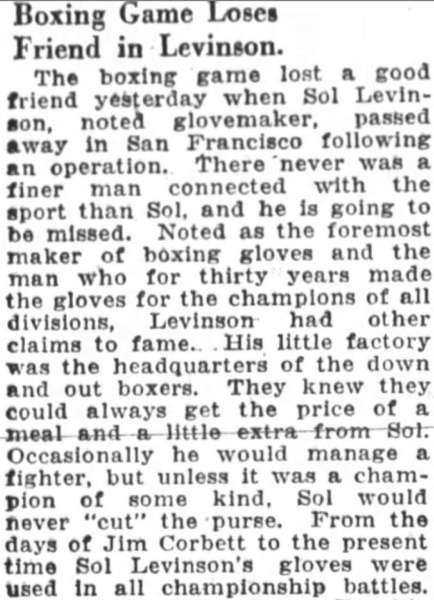
Source: Oakland Tribune (Oakland, California) • Tue. March 5, 1925 • Page31 Across the bay, The Oakland Tribune remembered. “Boxing Game Loses Friend in Levinson.” “The boxing game lost a good friend yesterday when Sol Levinson, noted glove maker, passed away in San Francisco following an operation. There never was a finer man connected with the sport than Sol, and he is going to be missed. Noted as the foremost maker of boxing gloves and the man who for thirty years made the gloves for the champions of all divisions, Levinson had other claims to fame... His little factory was the headquarters of the down-and-out boxers. They knew they could always get the price of a meal and a little extra from Sol…Occasionally he would manage a fighter, but unless it was a champion of some kind, Sol would never "cut" the purse. From the days of Jim Corbett to the present time Sol Levinson's gloves were used in all championship battles.” 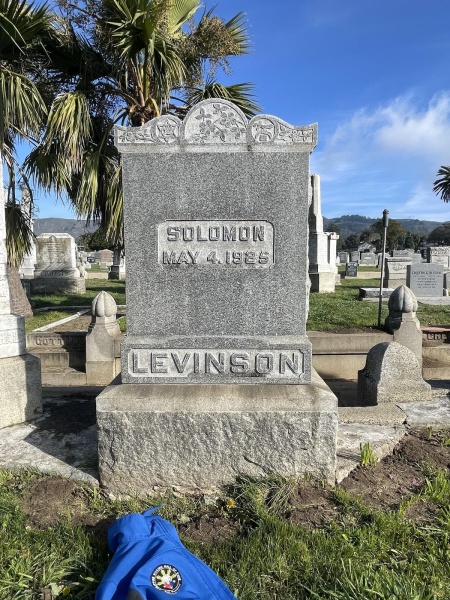
He was laid to rest at Hills of Eternity Cemetery in Colma, California. (Photo courtesy of the Philippine Boxing Historical Society, circa December 2024) Today, original Levinson gloves are rare collector’s items, preserved by boxing historians and fight enthusiasts. 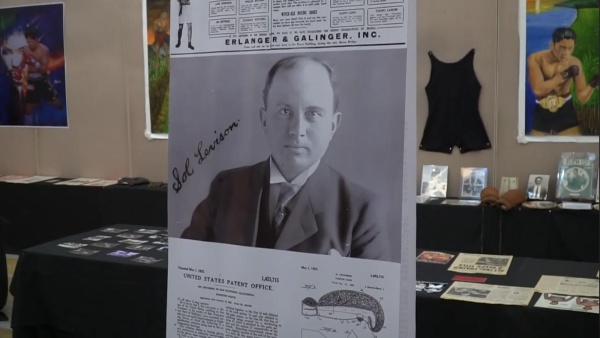
Exhibit: Philippine Boxing Historical Society and Hall of Fame on March 22, 2024 (Manila Grand Opera Hotel and Casino, Santa Cruz, Manila, Philippines) Sol Levinson’s Influence on Filipino Boxing Levinson’s influence was global and his fist armors were shipped to pugilism hotbeds like Australia and England, even appearing in unexpected places like a village called San Mateo in Luzon, Philippines, during the Philippine-American War. Damon Runyon, the reporter of acclaim and former US Army soldier who saw action in the Philippines from 1888-1899 during the Spanish-American and the Philippine-American War, did not realize Levinson’s reach until much later. In his syndicated column RUNYON SAYS- one for the Star Tribune (Minneapolis, Minnesota) • Tue, Aug 10, 1926 • Page 15- he confirmed the connection of Sol Levinson and the earliest proof that Americans taught the art and science of boxing to the Filipinos. “The cavalrymen went on and took the town of San Mateo and they found among the possessions abandoned by the fleeing insurrectos a set of boxing gloves made by the late SoI Levinson, of San Francisco. “The American soldiers were curious as to how the boxing gloves came to be in San Mateo and some of the Filipino prisoners explained that they had been brought in by a renegade soldier from the negro Twenty-fourth Infantry and that he had been schooling the Filipinos in their use.” 
Many of the best Filipino boxers of olden times— from Eddie Duarte, Francisco Labra, Silvino Jamito, Macario Villon, Dencio Cabanela, Pancho Villa and Ceferino Garcia to Small Montana, Little Pancho, Young Tommy and Little Dado— trained and fought wearing Levinsons. Francis Aglar Churchill, the American promoter who built the Olympic Stadium in Santa Cruz, Manila, and is considered the Father of Philippine boxing, required his fighters to wear Levinson gloves. Sol Levinson was an original just like his gloves that changed boxing forever. His mitts gave fighters better protection, confidence, and control— revolutionizing the sport in ways still felt today. And though time has passed, his name remains underscored in the history of the squared circle— a legacy built, quite literally, by hand. Sources, References, and Notes of Appreciation: • We at the Philippine Boxing Historical Society and Hall of Fame are eternally grateful to late Messrs. Jack Fiske of the San Francisco Chronicle and Al Corona of the San Francisco Examiner for their generous bequest of a few sets of Mr. Levinson’s gloves worn by Filipino boxers of renown. The collection they helped inspire has continued to grow, and through these tangible artifacts, we are privileged to preserve and share the memories they represent with our fellow fans of the fight game. • Top Photo: The Birmingham Post (Birmingham, Alabama) • Wed, Apr 13, 1921 • Page 8 • Select biographical details are quoted and adapted under Fair Use from “Solomon Levinson: From Kid Gloves to Boxing Gloves” by Jeremy Frankel and Victoria Fisch (Western States (Western States Jewish History, Winter 2015/5775, Vol. XLVII, Number 2) • United States Patent Office, Patent Numbers 1453714 and Registered Trademark 161201 • San Francisco Chronicle, May 5 and 6, 1925 • The Bulletin (San Francisco, California) • Sat, Mar 2, 1918 • Page 8 • Oakland Tribune (Oakland, California) • Tue. March 5, 1925 • Star Tribune (Minneapolis, Minnesota) • Tue, Aug 10, 1926 • Page 15 • Jewish Museum of the American West, Solomon Levinson: Jewish Boxing Glove Manufacturer of San Francisco, Exhibit Curated by • Samantha Silver https://www.findagrave.com/memorial/97296970/solomon-levinson • All photos and excerpted quotes and references in this tribute comply with the US Fair Use Doctrine 
(L-R) One aspiring writer and his editor Mr. Dong Secuya at 1028 Market Street, San Francisco, California (January 29, 2025). It was great to once again see Mr. Dong Secuya, founder and creator of the greatest boxing website, PhilBoxing.com. Click here to view a list of other articles written by Emmanuel Rivera, RRT. |
|
|
PhilBoxing.com has been created to support every aspiring Filipino boxer and the Philippine boxing scene in general. Please send comments to feedback@philboxing.com |
PRIVATE POLICY | LEGAL DISCLAIMER
developed and maintained by dong secuya © 2025 philboxing.com. |